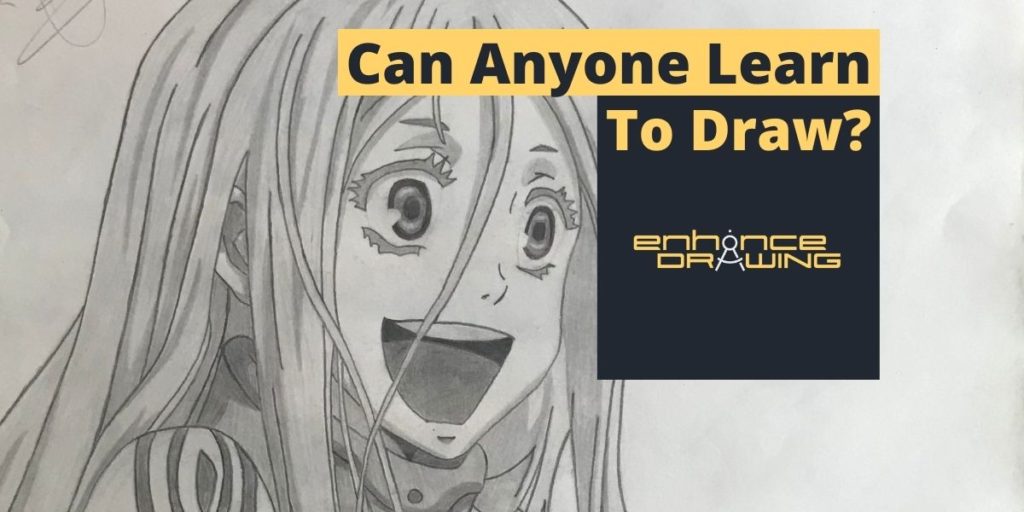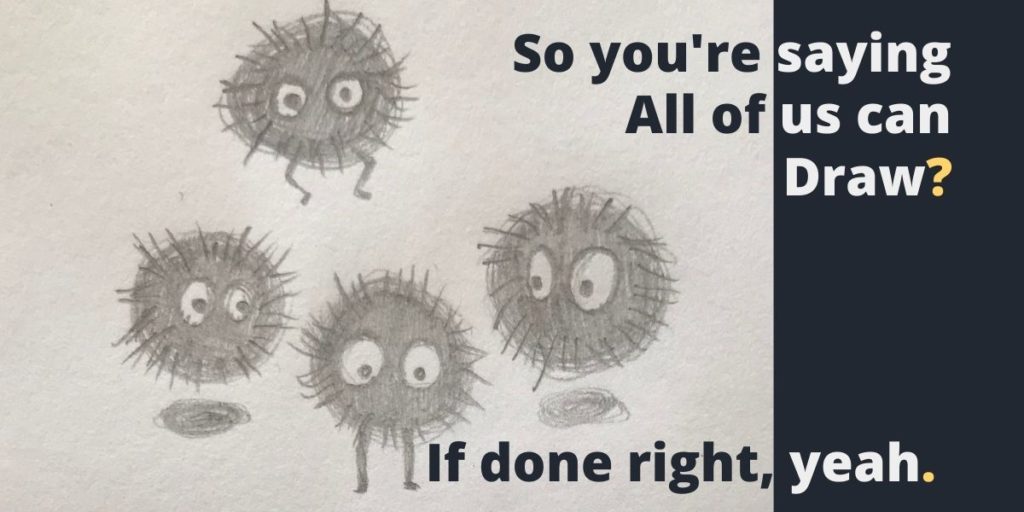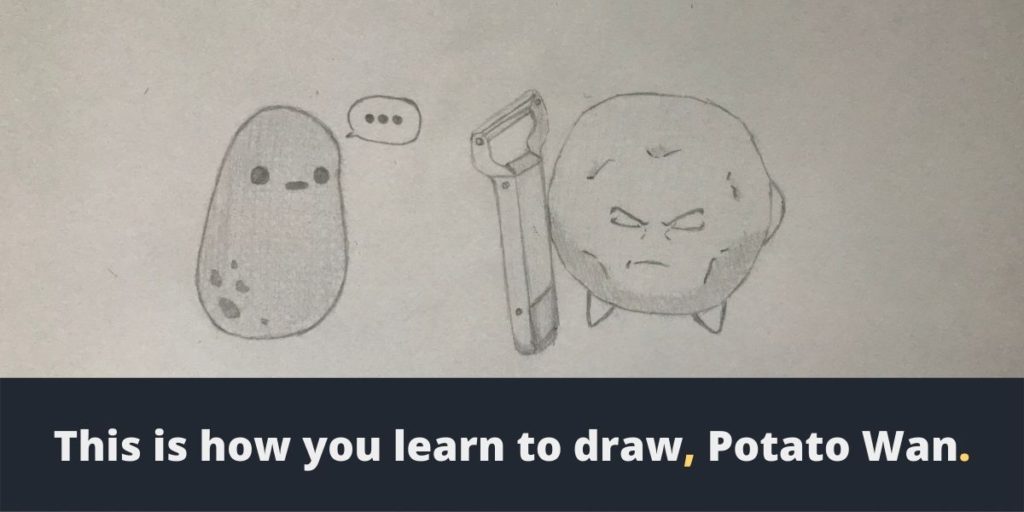
I was about 10 when I decided I wanted to learn to draw, and I remember myself not getting anywhere no matter how hard I tried. Not seeing progress made me feel I couldn’t draw, but I kept thinking that if other people could draw, anyone could draw. But is that true? Can anyone learn to draw?
Anyone can learn to draw by following a proper method, consistent practice, and a good drawing routine. Any person can learn and develop any skill, and drawing is not an exception to the rule. Anyone can learn how to draw by putting in the effort and time to do it, including you.
Still, although anyone can learn to draw, many people feel that they cannot. So in this post, I’ll walk you through all the factors that may be preventing you from being a great drawing artist, how to solve those problems to know if you can draw, and show you that if you want to, you can learn to draw.
Can Anyone Learn To Draw?
Finding the correct answer to whether anyone can learn to draw was a complex task, mainly because this is quite a controversial question. On one hand, I found that the popular opinion was that only a few people could learn to draw (most people in internet forums). And on the other hand, I found that the view of more informed, skilled, professional artists was always that, with enough practice, anyone could learn to draw.
So right now, we identify two things: everyone can learn to draw, but not everyone accomplishes it. When you put it like that, it sounds like only a few people can learn to do it instead of confirming that anyone can draw. This kept me thinking: what is this thing pro artists know that most people don’t know that makes them say anyone can draw so confidently? So with that premise in mind, I went ahead to ask every art teacher I had, every artist I knew, and every TED Talk there was about drawing and try to grasp what they had in common.
I finished gathering information, and I ranked all the reasons they gave me in order of importance. In the end, I found a straightforward answer: not every person is disciplined enough to practice drawing every day and has the patience to see results over time. Of all the reasons they gave me, this is the main one that keeps people from achieving their artistic goals. And it makes a lot of sense, not only for drawing but for any goal you have that requires discipline, practice, and time. Even the great artists say it:
If people knew how hard I worked to get my mastery, it wouldn’t seem so wonderful at all.
-Michelangelo.
Tip #1: If learning to draw has taught me anything, it is this: you have to work hard for your objectives. Otherwise, you will never see them accomplished.
To put it simply, anyone can learn to draw, but you have to put in the time and work to deserve it. But that’s good news! We already love to draw, so we just need to keep doing it and follow a good drawing plan.
So, now that you know there is a way anyone can learn to draw, let’s see what you need to keep in mind to find if you can do it.
How To Know If You Can Learn To Draw

It turns out that being able to learn to draw is more related to your habits and discipline than to some kind of magical talent. So, since these are factors you can improve on, you can definitely learn to draw. First, however, you must know what it takes to learn to draw to set realistic goals and pursue them. So, let’s go over the things you need to keep in mind. If you can do these, you will learn to draw much faster than the average person.
- You need to be disciplined and consistent. Learning to draw well is not something you will learn in a week. On the contrary, depending on your goals, it could take you from months to several years. I have a blog about the time it takes to learn to draw so you can define your short, mid, and long-term goals.
- You need to follow a proper drawing routine. Practice makes perfect, and this is especially true when drawing. To achieve a good drawing level, you need to draw every day. One hour a day is the minimum time you should be aiming to practice every day, but the more hours you put into drawing, the faster you will see results. The artist I admire the most, Kim Jung Gi, draws for more than 8 hours a day! I recommend three hours if you just started.
- You need to learn the drawing fundamentals and have a plan. As a primarily self-taught artist, I saw that most of my weaknesses in drawing came from not knowing or understanding the fundamentals. Every artist has a different way of learning, so feel free to create your own plan, but please do create one. (If you need guidance on how to create a drawing plan, I will talk about it later in this post) I cover some drawing fundamentals here at Enhance Drawing. Feel free to use them to improve your drawing skills!
- You need to organize your priorities and place learning to draw where you think it fits best. Creating this list of priorities will help you understand if you really want to learn to draw or see it as a hobby. If your goal is to be the greatest artist ever, but drawing is the least of your priorities, you will never be the greatest artist. In most cases, every great artist you see lives for drawing, and many of them make a living out of drawing. If you’re good with drawing eight hours a day and you plan to make art your life, then go for it and find a way to make it work! If it is a hobby, practice whenever you feel like drawing and keep in mind that you can get very good at it if you do it for long enough.
Tip #2: Don’t let destructive criticism take away your dreams. Most people in the world are unconscious of the damage they can create with their words. You will always find good or bad people in your life, so it’s essential to decide who you listen to when talking about your goals!
In conclusion, if you’re willing to take action and stay consistent, something most people can’t do, you will be able to learn to draw. The most important thing you need to do to learn to draw is a lot of drawing and practice. To make sure you start this journey following the right path, I will help you develop a plan you can follow to begin drawing.
How to Learn To Draw?

Even if you’re new or have some experience drawing, this drawing plan will work wonders for you. So, let’s try to keep these actions as easy to follow as possible. After the actions, we will set up our schedule.
- Pick the time you will draw every day. For many professional artists, I included, consistently drawing every day is the most important thing you have to do to become a great artist. To do it, place all the 24 hours you have a day and take away the hours you sleep, eat, work or study, and any other thing you consider important; once you do that, see how many free hours you have available and decide how many of them you want to use for drawing. As I stated above, I recommend three hours of drawing a day, but at least an hour a day is necessary if you want to see consistent results. Depending on how badly you want to learn to draw, consider drawing even for more extended periods!
- Study basic perspectives. I know there are many things you want to draw, and that perspective doesn’t seem like the most exciting thing to do, but I think dominating perspective differentiates a great artist from an average one. In fact, perspective is the most common thing most artists get wrong when drawing. Everything you see has perspective, so it’s crucial to understand it to draw anything.
- Study basic anatomy. Depending on what you want to draw, it’s important to understand the subject you will be drawing. If you want to draw people, study human anatomy. If you want to draw animals, study their anatomy. People and animals are the hardest subjects to draw, so you’ll be fine learning to draw anything else if you learn to do it. Remember, you’re learning only the basics here! There’s no need to become a master of anatomy when you just started to draw.
- Study value (light and dark). One of the things that will make your drawing look alive is shading them. Shade every drawing you make and practice it whenever you can.
- Draw what you want to draw (using references). Be you and draw whatever you feel like drawing, but remember to use references. Drawing from reference is not cheating, and it can be a great indicator to identify how well you can draw anything.
- Free drawing. If there are things you want to explore, this is the perfect time to do it. However, you can use your free time to continue practicing what you were already practicing.
Now you know what you need to do, create your own drawing routine. In the beginning, you study and practice each of the actions day by day. To give you an example, let’s say you start your drawing routine on a Monday.
- Monday would be the day you practice perspective.
- Tuesday would be the day you practice anatomy.
- Wednesdays would be the day you practice shading.
- Thursdays would be the day you draw from reference.
- Fridays would be the day you draw anything you want, with or without references.
Based on this schedule, Thursdays and Fridays are the days you test your progress by drawing and trying to apply what you learned in the first three days of the week. Then, on Saturdays and Sundays, you can work on your weaknesses. For instance, if you identified that your drawings don’t look like they have the right perspective, work on that. If you see you lack shading skills, work on that. Continue doing this day after day, and you will see progress in no time!
Tip #3: Be patient. Drawing is an enriching journey, and it is worth the time you put into it. Remember, anyone can learn to draw, but only those who put in the effort to do it are the ones that succeed. You can learn to draw, but you need to deserve it!
Can You Learn To Draw Without Talent?
I’ve met many artists in my life, and if there’s something I’m sure of is that not every artist is born with an exceptional, magical gift for drawing. In fact, most great artists I’ve encountered always told me that their drawing skills come from all the hours and practice they have put into it. Even the artists I haven’t met in person say it in their interviews and books: the only way to enhance your drawing skills is to draw a lot.
But in short, can you learn to draw if you have no talent? Anyone can learn to draw without talent. Drawing is a skill that can be taught, practiced, and developed. Talent helps artists learn to draw faster, but even talented artists need to practice to improve their drawing skills.
Of course, talent contributes a lot, but it isn’t required for anyone who wants to become a great artist. The only difference between a talented and less talented person is that the less talented person will have to work harder to achieve the same mastery. However, once you reach that mastery, drawing will be so natural that you will feel like you acquired the talent to draw. After that, you’ll draw much better and learn things much faster.
Is Drawing A Talent Or A Skill?
Answering if drawing is a talent or a skill is as controversial as answering if anyone can draw, so instead of giving a quick answer without any background, you can visit this blog post I created in which I answer if drawing is a talent or a skill. I polled many people and gathered as much information as possible to give you a concrete answer, and it’s interesting to see how people see it! But if you’d like to have a quick answer, is drawing a talent or skill?
Drawing is a skill, and anyone can achieve a proficient drawing level with enough time and practice. However, although talent helps artists develop their artistic techniques much faster, the skill that comes with drawing practice generally overcomes talent.
Before we go any further, I’d like to make sure that drawing is also a talent, and there is a big chance that the most recognized artists of all time had a special talent for drawing. However, many of them are proud to have achieved their drawing skills through constant drawing practice. So, in conclusion, drawing has skill and talent at its core, but skill is what you need to draw better.
Tip #4: If you think you don’t have any talent for drawing, think about it again! After so many years drawing and meeting so many people, I saw that many people that thought they didn’t have a natural talent for drawing found they actually did after some years. Everyone has a talent; you just haven’t found it yet!
Can You Learn To Draw At Any Age?
Another thing that makes people doubt themselves is their age. Usually, people older than 20 wonder if they are too old to learn to draw, mostly because they see much younger people drawing at extraordinary levels. However, the good news is that anyone can learn to draw, regardless of their age. For me, the main reason most older-than-20 people don’t see results when drawing is that they don’t have enough time to practice. Hence, they don’t see quick results and think they cannot draw because they are too old.
Tip #5: Learning to draw isn’t a race. Everyone learns to draw at their own pace, and there’s no shame in taking a little extra to learn anything. I’ve studied drawing a lot, and I’m not yet at the level I would like to be, but it doesn’t bother me! For me, the most important thing about drawing is the peace and joy it brings me.
Can Anyone Get Good At Drawing?
Just as anyone can learn to draw, anyone can get good at drawing. Getting good at drawing requires time and practice. Since everyone has time and everyone can practice, anyone can get good at drawing! The important thing is to draw every day and be patient. If you draw often, results will naturally show.
I hope this post helped you in any way, and I hope you achieve your artistic goals. If you’d like to continue learning about drawing, feel free to continue reading here at Enhance Drawing! I have many drawing tutorials, posts about the drawing fundamentals, and other common questions about drawing that might interest you.
Happy drawing!
